Meeting agenda:
- Icebreakers and Introductions
- Ask about daily life: activities, hobbies, etc.
- Ask about any difficult aspects of daily life
- Quickly evaluate feasibility of making any aspects of daily life easier
- Maybe: pitch underdeveloped ideas as solutions to problems and discard the solutions that are too difficult to pursue
Meeting summary and major takeaways:

Notes.

One finished blanket.

A blanket with newly-punched holes.
After meeting with Kathy 3 times, once on campus and twice at her home, it became apparent that there were no major difficulties in her life that we could potentially fix. We had issues with each project idea that was considered. One option was to create an automated cloth blanket formatter that would punch holes along the edge of the felt. Kathy felt that it inconvenienced users to have to punch the holes themselves with the tool given that it required more moving and larger tables than entirely necessary. While a perfectly plausible plan, the handling of fabrics would have posited a difficult hurdle, as cloth mechanical engineering is a monster of a problem. Another plan we thought up was an automated jar opener. However, as many of these were out on the market and the parts of the opener would be difficult to mechanically achieve, we vetoed this idea as well. Lastly, we noticed that she had trouble pulling pots and pans from the back of her cabinets. She would have to get on her knees and pull pans out on the counter in order to use the less-common pans, which inconveniences her. Ultimately, the fix for this problem falls under the work of a carpenter, and carpentry is not the purpose of this class.
After much discussion and deliberation we settled upon the idea of an automated light switch on a timer. Of all the ideas that were discussed many were either unsuitable for this project or would not have been of any use to Kathy. She mentioned that since she lives in a two-story house and resides mostly on the second story, it is inconvenient for her to turn on her downstairs porch light, send her guests off from her upstairs window, and then go downstairs to turn off the lights again. In this case, either a remote-controlled or timed switch for a light would definitely help her combat this annoyance, and would fit within the bounds of what we are able to do.

Notes from second in-home meeting.
Our goal is to create a personalized device that will assist an individual in some aspect of their life. In pursuit of this goal, we (Karen and Ian) first needed to learn more about the person we’re designing for, Elinor. Since Elinor was out of town the past week, we had a quick phone call to introduce ourselves and the project briefly before our in-person meeting. We drove out to the suburbs of Wexford, PA, on Friday, March 29th to meet with Elinor at her house, learn more about her life + daily routine, and get to know what type of device might be helpful for her. When we met in person, we focused on seeing her house and environment, as well as learning more details about her lifestyle.
Meeting agenda
Since we met with Elinor first on the phone and then in-person, we planned on learning more basic information about her first, such as:
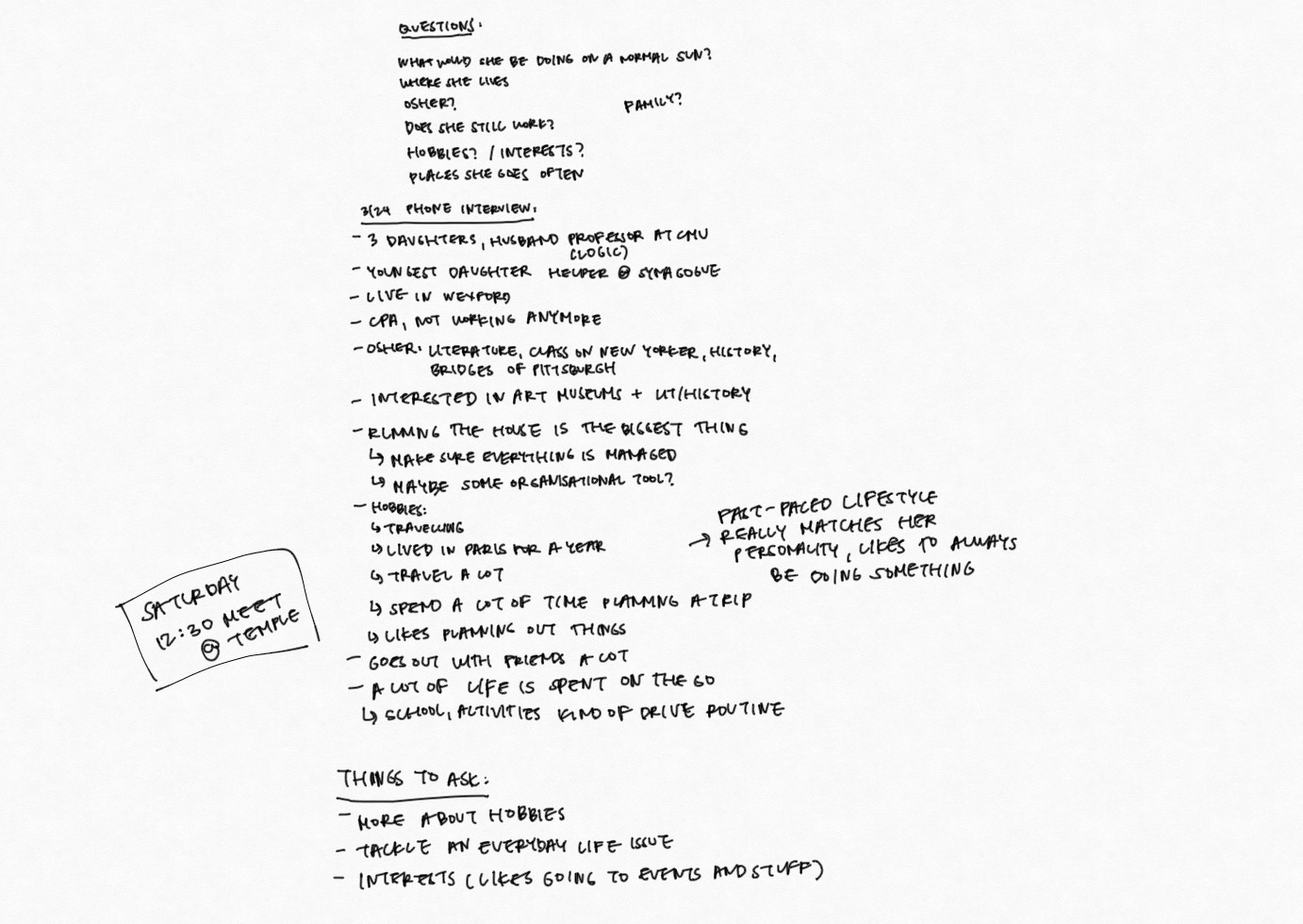
Handwritten notes before interview
After our phone call, we were able to get a sense of her personality and a quick rundown of her daily lifestyle. We were still left with some questions about her hobbies, interests, and what types of issues she might encounter on a daily basis, so we were looking forward to seeing her face-to-face. Before going to her house, we came up with some basic ideas that we wanted to ask her about:
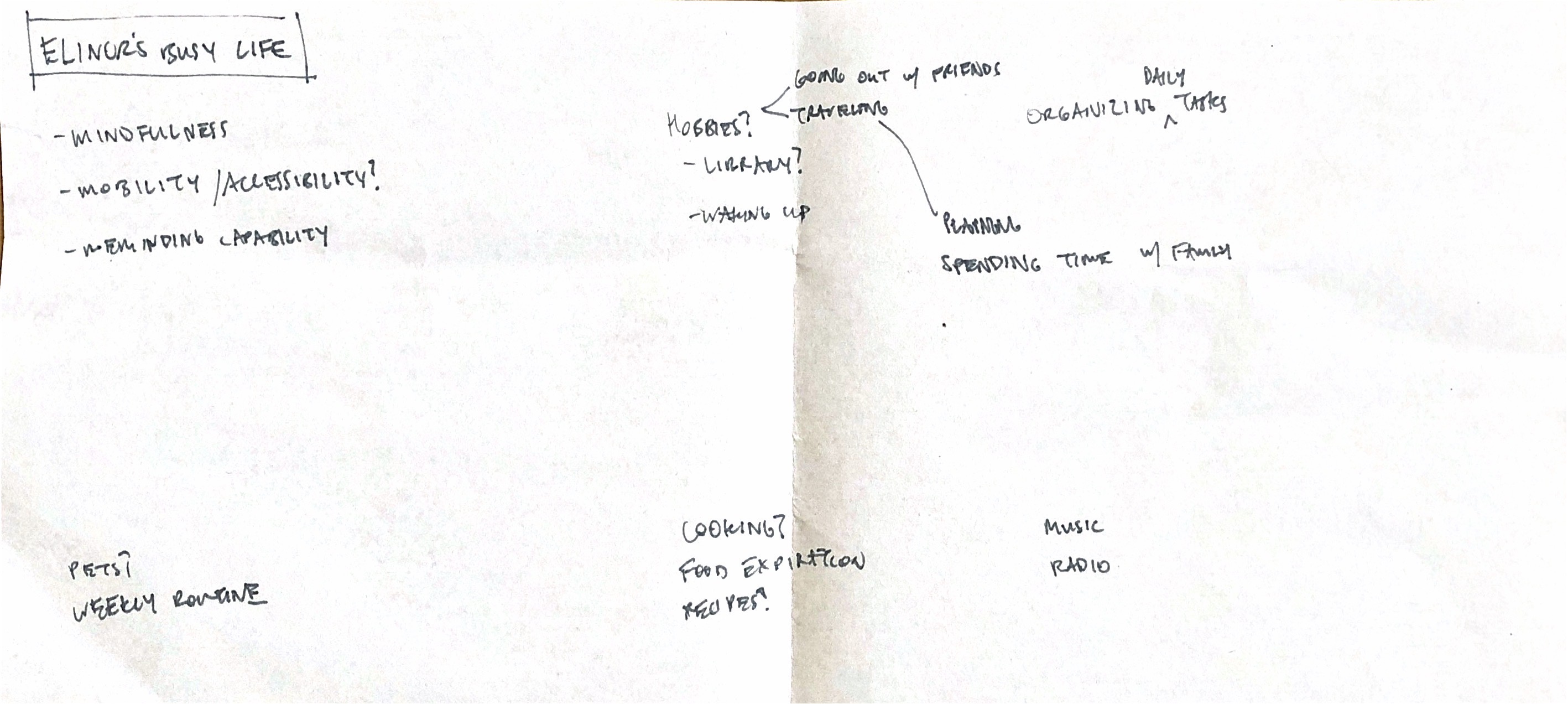
Scanned notes before meeting
For our interview with her, we loosely planned an agenda on our way to her house and wanted to structure our meeting something like this, although we planned on adapting our questions based on any new information we learned or if anything came up that we wanted to address.
- Introduce ourselves and our objective through this project
- Ask about her participation in OSHER classes and some more information about classes she has taken
- A tour of her house and ask her about how she spends her time at home
- Ask her to tell us about her daily routine and hobbies
- Ask about her electronic devices and how she might organise her schedule
- How does she spend her free time
- Ask if she has any issues in her daily life that she might want help with
- Ask her about some ideas that we had after our phone interview, such as mindfulness
- Wrap up, take any photos if needed, say thank you
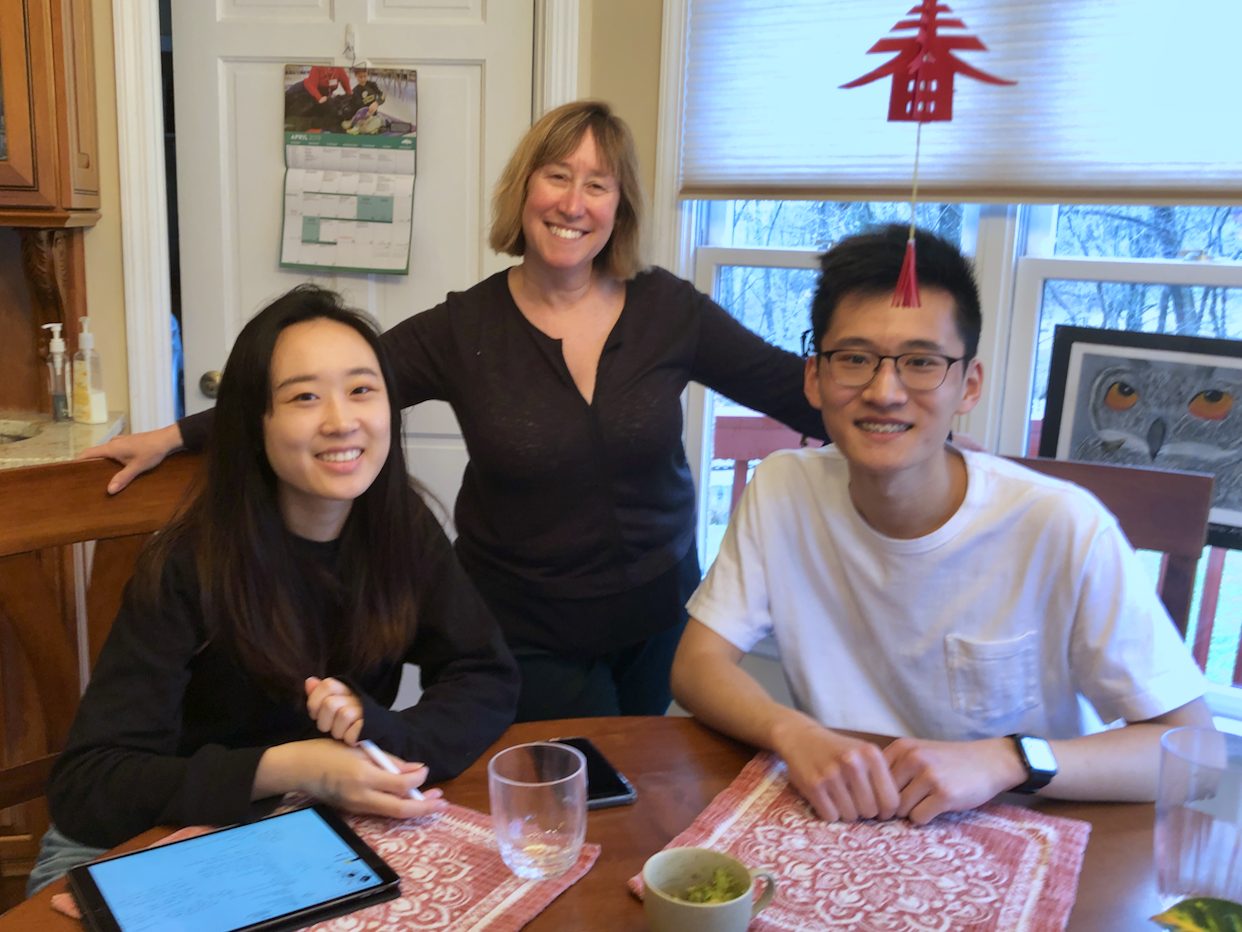
Photo of the three of us, courtesy of Elinor’s daughter Ariella.
Summary + takeaways
Through our conversations with Elinor, we learned that Elinor maintains an active lifestyle and most of her time is spent organizing the lives of her three daughters and other miscellaneous errands that take up her day. Elinor also enjoys travelling, handling investments/stocks, and working with other families in college planning. She described her day-to-day lifestyle as pretty varied and dependent on matching up many different schedules and activities, so we thought that this could potentially be a space for us to explore. Although Elinor really enjoys planning and staying busy, including going to the gym regularly in the mornings, she admitted that she often doesn’t have time to herself to relax and focus on her mindfulness.
Something else that Elinor brought up was that it’s really tedious and time-consuming to organise her mail, since she receives so many different types of mail on a daily basis. Currently, her mail sits in a bag or on her desk before she finds time to go through each one by one. A system that could sort through her mail and keep track of dates when her mail was received seemed like it would be helpful to address this problem.
After going on a tour of her house we learned that her house stays pretty organised and that when Elinor is at home (which isn’t too often), she spends most of the time at her desk on the computer. She also uses an Amazon Echo to play music or do basic commands, and mentioned that integration with her device to serve as a communication device with her daughters would be helpful as well.
Post-meeting
Prior to meeting our client, we were somewhat led to believe that they would require assistance with daily tasks due to their age. However, in our conversations with Elinor, this was clearly not the case. She is about the same age as our parents, raising daughters who are the same age (or younger) than we are. Having recently left her job as a CPA, Elinor has more time to devote to her daughters’ activities, including traveling, managing college applications, and attending extracurricular activities. One could say her energy level exceeded ours, and even conditions that people start to get in their forties (hyperopia or knee issues, esp. when going up and down stairs) she did not have. As a result, our conversation centered around her daily activities. At one point, we were talking about our experiences applying to and attending college. In that sense, it was less of an ‘interview’ with strict question-asker and question-answerer roles and more of a conversation with a friend.
Perhaps if we entered the conversation with that mindset, instead of trying to find an apparent mobility/functional area that could be solved, we could have started ideating on what the device would look like, what it would do, and how it would work, with live feedback from the client. Of course, this can still be accomplished later through email or over the phone/FaceTime, but it would have been nice to have more fleshed out project boundaries earlier in the process.
Overall, we both thought that our meeting was productive and it was really helpful to learn about Elinor in her home environment.
]]>At the initial meeting, we wanted to gain some insight into what our client, Lois wanted for her assistive device. We met Lois last Monday at her home on Monday, March 25, at 9:45 AM.
Meeting Agenda:
We planned out the meeting on a Google Doc and had a series of questions on hand during our meeting. During the meeting, Elena took notes and photos, Connor spoke to Lois, and Aditi spoke to Lois and took notes.
Introduction
- We began the meeting by introducing ourselves, our major, our year, as well as our hometowns
- Lois discussed her background working in the Allegheny School District, her knowledge of Pittsburgh public transportation, her cats(!), as well as the Dirty Dozen race
- Told her about the parameters of the project as well as deadlines and our background knowledge and skills
Project Discussion
- We started the meeting by asking Lois if there were any prominent areas in her life that she had trouble with frequently. She stated that she had some issues with the volume on the television fluctuating when commercials come on. We believed the project to be impossible within the scope of what we learned in this class
- Lois told us about her organization issues and described her process of organization she takes with her personal files, music, and “work” files.
- We asked to see her “piles and piles of random stuff” and she brought them over to the table. Once she receives mail and other papers, she puts them in piles around the house that she cannot keep track of
- After discussing possible project ideas and narrowing the scope of what we were going to focus on with the organization idea, we asked to see how she stores files currently in her home.
End of Meeting: Tour of Home
Lois took us around the house to show us where she kept her music sheets, important documents, and something she holds very dear–her father’s letters. Through the house tour we saw what she described in the meeting as well as the scope of the problem we were trying to fix. At the conclusion of the meeting we told Lois we would keep her updated on the process of the project and which idea we were going to go with.
Summary:
At the start of the meeting, we learned a lot about Lois. As a native to Pittsburgh she had a lot to say regarding the ways that her city has changed. In particular, she described her home town, Beechview, and the commuter train that runs through there. It was important getting to know Lois, so we let her talk for a good 15 minutes on this topic.
After, we decided to jump right in by giving Lois a description of our project guidelines and timeline. We were pleasantly surprised by her preparedness. She started off with an idea that noticeably made her excited. The idea was to create a TV volume regulator. Lois and Irv were sick and tired of changing the volume levels countless times due to loud commercials. We decided that this project was a good option, but quickly moved on from it in order to keep the meeting flowing. I think we cut this idea short and should have asked Lois for more information because it is well within the scope of the class. Not to mention, Lois seemed very interested in solving this problem.
Moving forward, Lois went down her list of ideas. At the bottom of the list in all caps were the words “CLUTTER” and “ORGANIZATION.” The capitalized letters showed us that this is a serious problem. Thus, we decided to ask her the most questions regarding the organization of her piles of papers. Her situation was that she has an issue throwing away papers, however, instead she throws them into massive stacks that sit in her and Irv’s office. Our original idea for a solution involved some sort of scanning device so that she never had to worry about physical paper clutter. She was intrigued by the idea, but ultimately feared a shift to strictly digital organization. This was largely due to the fact that she kept hard files that were very valuable to her. For instance, her fathers notes to her mother and her mother’s health documents. So we tried to get some more specifics about her papers. She then brought from her office a small sample of one of her massive piles of papers. At the table we each sifted through and she explained what value each document had. Right then and there she also decided that there was a handful that she could already throw out. Thus, we noticed that a decent percentage of the documents she has are ready to be put in the trash. A specific branch of the paper clutter was her sheet music. So we decided to brainstorm ways to organize that in a certain file cabinet kind of way. We showed her a past project that involved rewarding the user with candy upon placing a paper in a file. She was not a fan of this idea saying, “Oh, that’s dangerous.”
At this point, our interview had lasted over an hour, but we had no concrete plan. So, we decided to ask her if she could show us around her lovely home to get a sense for the clutter. She brought us through her den and into the TV room where she had cabinets filled with old sheet music and cassettes. The sheet music was noticeably scattered in multiple parts of the house, which led me to believe that this might be out of our scope. Not to mention, she was unsure how she possibly organize it all because she would never remember the names or composers or dates of the songs.
Briefly thereafter, we left her home and said goodbye thanking her for her time. She emphasized that she hoped she didn’t waste our time, and we assured her she hadn’t.
Reflection:
During the interview we were able to collect a lot of information about Lois’s lifestyle and daily activities. Unfortunately, the interview was not as effective as we would have liked it to be. This owes to the fact that we did not spend a lot of time discussing the project we settled on as we had not anticipated that it would be feasible. As discussed above, Lois mentioned that she wanted a device to regulate the volume on her TV during commercial breaks. At the time, we were convinced that this would not be possible as it was both too complex and software heavy. Fortunately, after researching we realized that we could implement a volume regulator with a physical component. It would use a sound detector and IR transmitter to remotely control the TV. We found many projects which achieve this and we are currently brainstorming what additional features we could add that would be beneficial specifically for Lois and Irving.
We may have to make another visit to Lois’s house to have a closer look at her TV and overall setup of her den. A lot of details remain unknown , for example, where would we place the device in the room? If we were to place it near their couch is there an accessible power source? Would we need to have a higher minimum threshold to account for Irving’s hearing? Where is the IR receiver on Lois’ TV?

Lois showing her sheet music (with a small peek of the TV in her den)

Lois’ cat! A frequent visitor of the den, often accompanying Lois & Irv’s TV adventures.
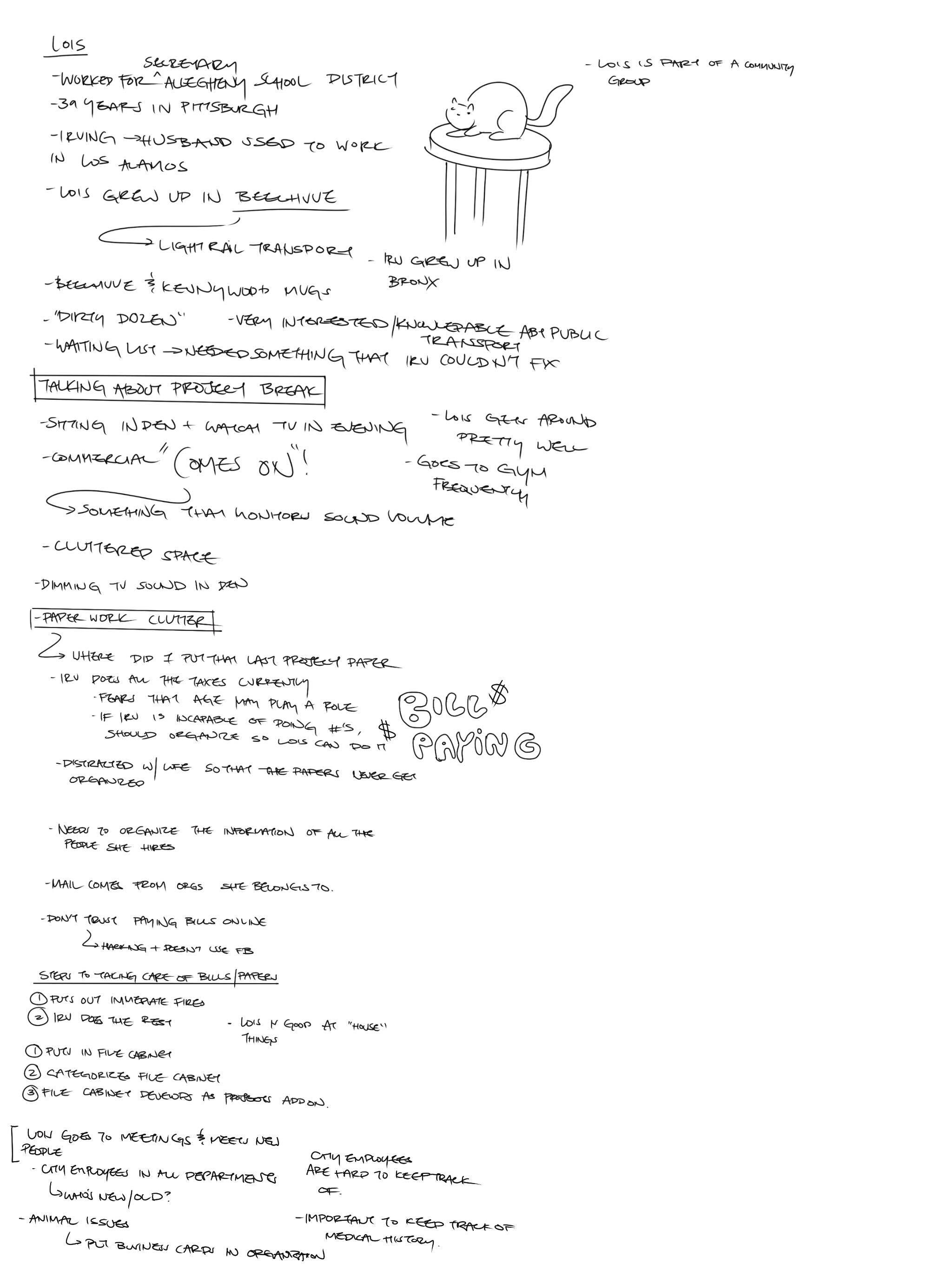
notes page 1
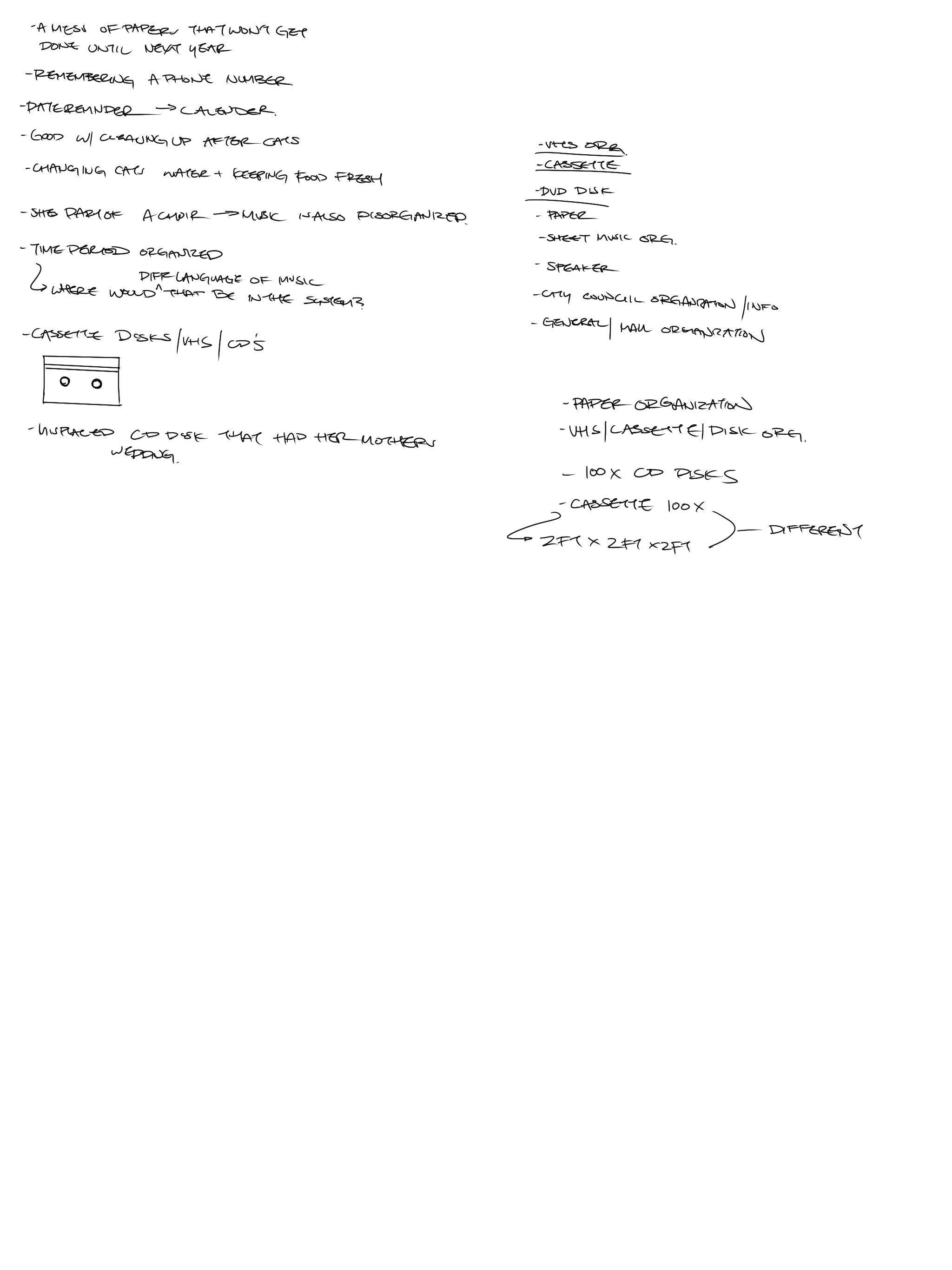
notes page 2
The purpose of this meeting, and more importantly the project, is to interview an older person to gauge their lifestyle and habits in the hopes to create something using an arduino that will better a part of their life. Our team, George, Enock, and Yael interviewed Emily, an older person living in the Southside of Pittsburgh. This interview took place March 22nd, 2019 and we asked about her history and current life. The documentation details our interview with her.
Agenda:
Before meeting with Emily we devised a small plan for the interview that would guide the conversation. We intended on asking a few guiding questions and seeing where those would lead, hoping that it would brew into a full fledged conversation.
- Ask about her past and why she is in Pittsburgh
- Ask why she is in the Osher class and has volunteered for this project
- Inquire about her daily lifestyle and specifically her day before we arrived @ 5:30 p.m
- Ask if she has any ideas beforehand for the project (to limit assumptions on our end)
- Hope for good conversation which will lead us to learning more about her without having pre-planned questions
Meeting Summary and Major Takeaways
As we approached Emily’s home, our Uber driver told us about the surrounding neighborhood. He mentioned how this area is known for parties and isn’t the safest. As we got out onto the street in front of her gate, we noticed a few teenagers loitering outside. They left when they saw her open the door.
After some introductions, we sat in her dining space and she told us a little more about herself. We found out that she is very confident technology. She plays Minecraft with her son and even read through the entire course website before our meeting. She also had a lot of sophisticated ideas for projects that could benefit her lifestyle.
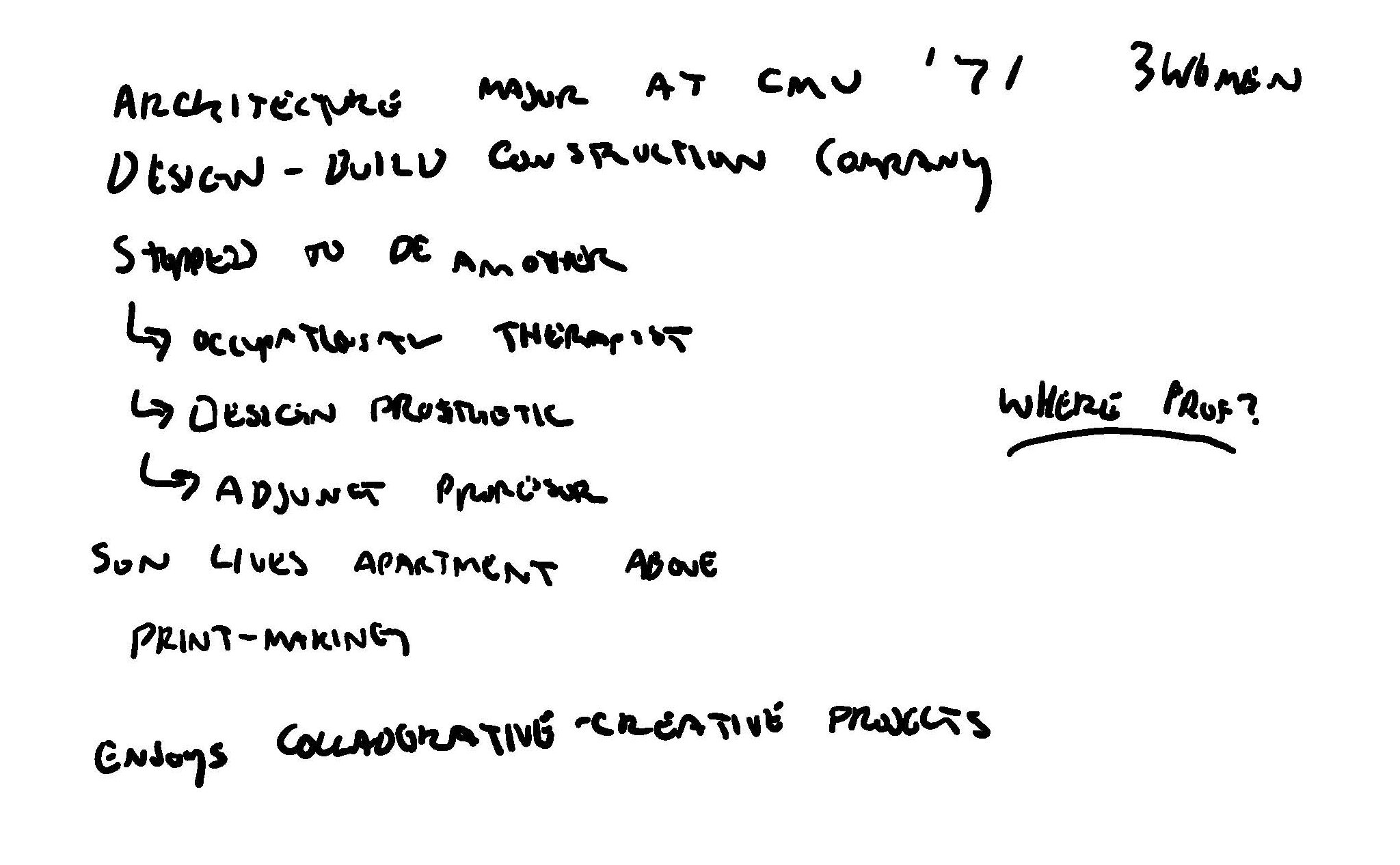

“Related to son?” is not doubting family relations, but considering if the project could benefit him as well.
She began by telling us about her usual day and the problems she has, as well as her proposed solutions.

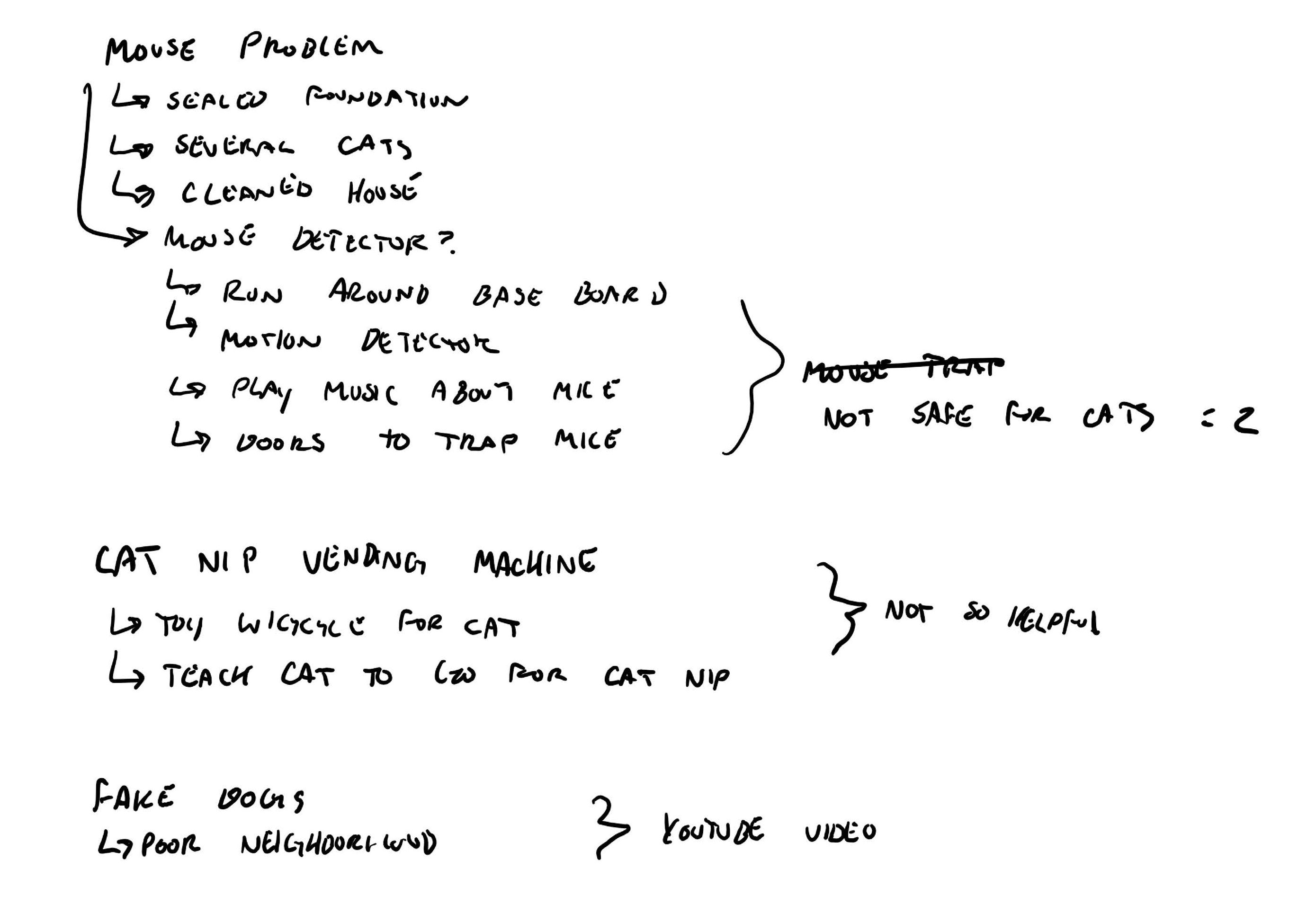
As she told us about her problems, our group discussed solutions for each but didn’t feel so confident about how interesting or special they could be. We pushed away from her brainstormed ideas and discussed her day to day life. Suddenly she mentioned how she often gets a call or text from her son during the day to bring in his packages or check for packages on the porch because teenagers in the neighborhood like to steal them. This intrigued us. It could be a solution for her package problem and it could also help her son. As well, if we loft the package safe box, the gadget will double as a safe box and a place to put her groceries, which will also help with her lifting difficulties.
We eagerly began brainstorming and discussing difficulties that may arise during design.
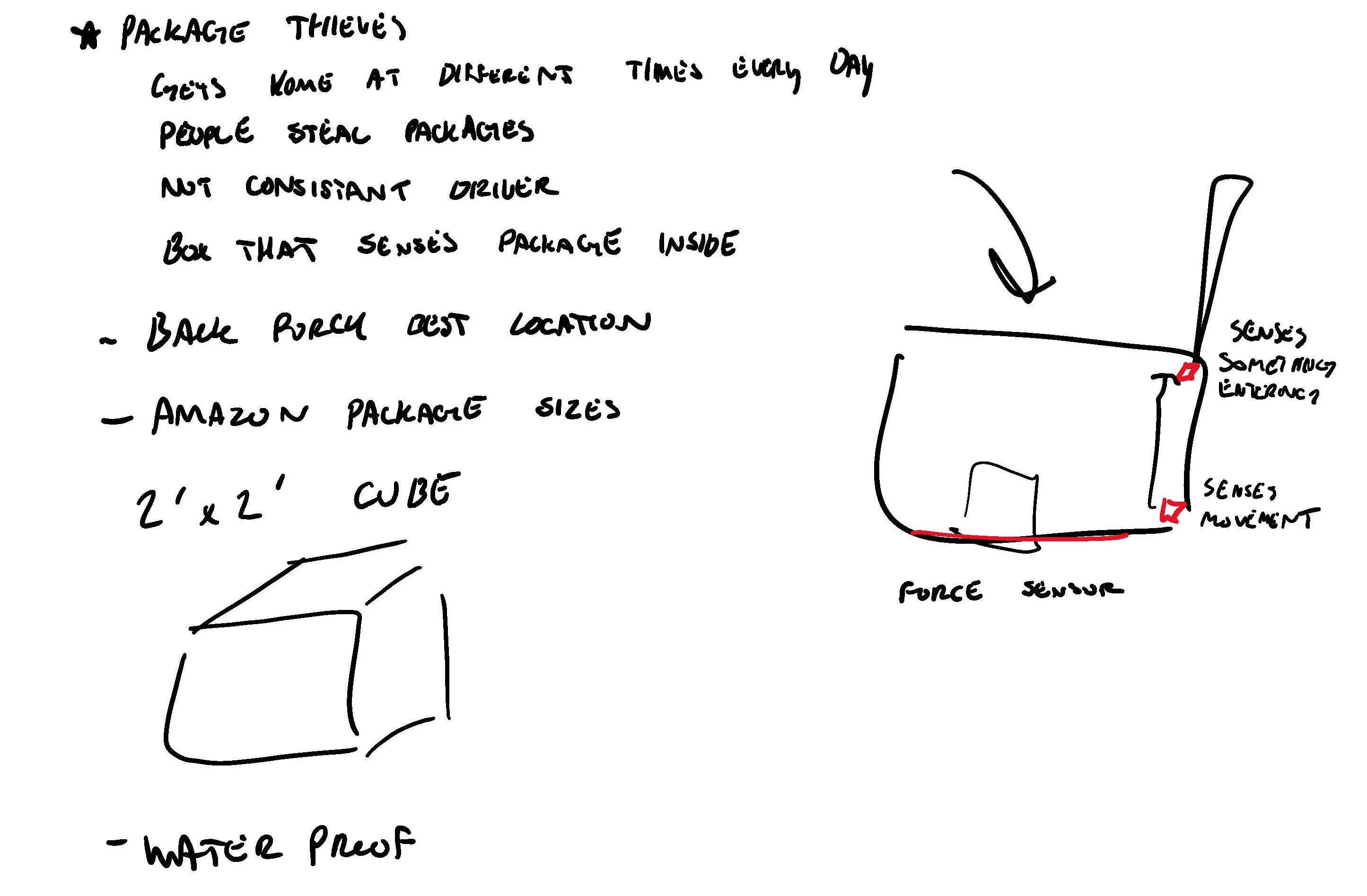
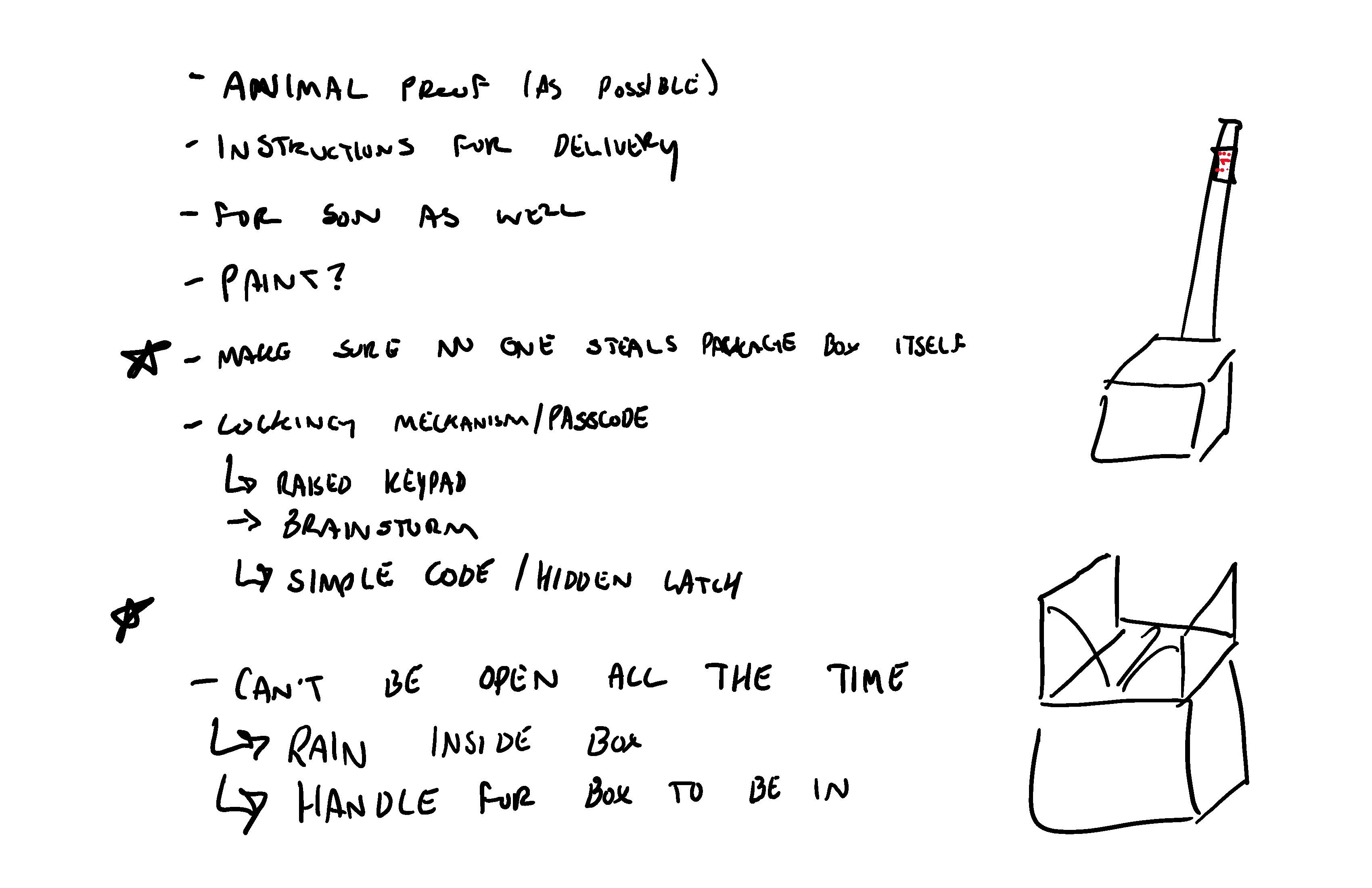
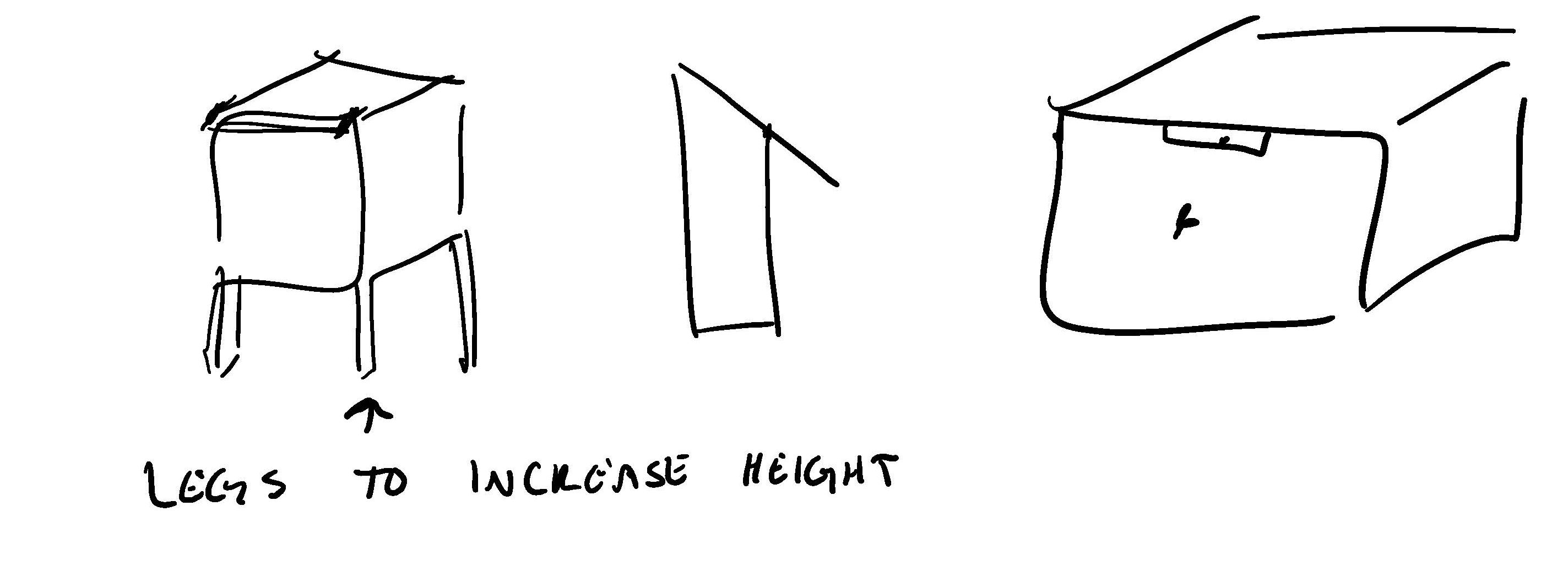
Discussion
Throughout our interview with Emily, we discussed many possible project ideas designed to aid in her daily life with varying degree.
While intriguing, our initial ideas where out of scope of the project. For example, one promising idea stemmed from Emily’s observation that she had trouble balancing when walking down the stairs. To combat this, she envisioned a gyroscope device which could sense when she was off balance and move her back on track. However, while such a device would undoubtable be very useful for her, the project would have been out of scope for our course because of the difficulty of designing a counterbalance device capable of balancing a person with our limited experience and tools we have access to. Another idea proposed was a catnip vending machine for Emily’s cats. The device would be fully interact-able, with her cat pulling on a rope to release a snack from the vending machine. However, we quickly found this idea was sub-optimal due to two primary realizations: 1) The device would be designed with Emily’s cats in mind instead of her, 2) The device would not be directly relevant to our course because it could be created entirely without hardware and circuits.
Following this initial discussion, Emily raised a point regarding packages being stolen from her porch. We learned there was a school bus stop near her home and on many days the school students would steal packages on their way home from the stop. We also found that this issue was exacerbated by package handlers occasionally carelessly tossing packages in her yard instead of her porch, making it easier for the thieves to take. Emily thought it would be great if there were a sort of ‘smart bin’ which could detect when a package handler was going to drop off a package and lock as soon as the package was dropped in the bin. This bin would further be animal-proof (it would not lock if an animal happened to get inside rather than a package), and water proof (it would keep the package safe from raim). Moreover, Emily described having problems with her back, and bending over for long periods of time, so designing the ‘smart bin’ would have to be done with this in mind to ultimately make it as easy as possible for her to use.
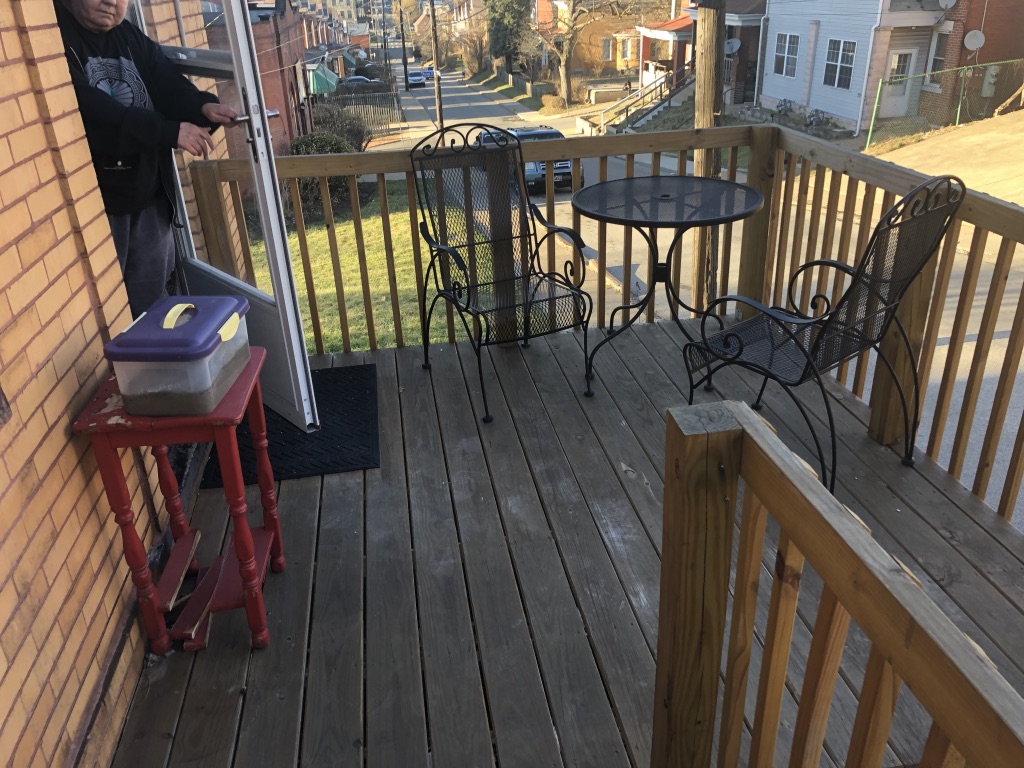
Emily’s porch, where packages are delivered and sometime stolen
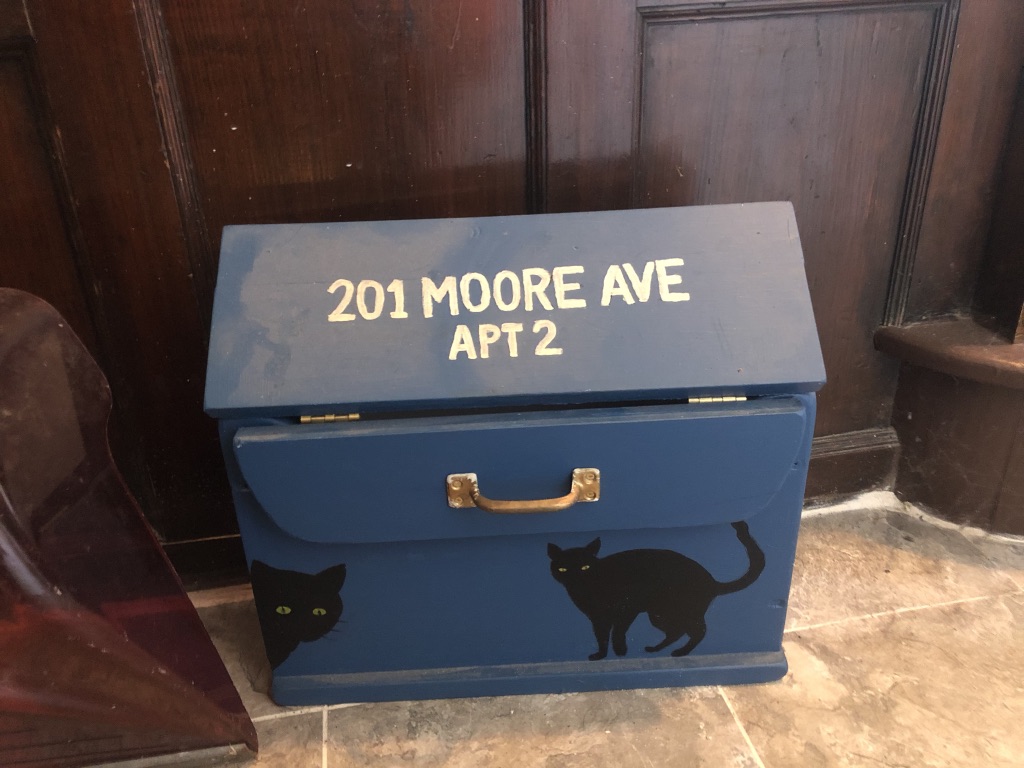
An example of the type of top our ‘smart bin’ could have. Such a top would keep the package safe from rain
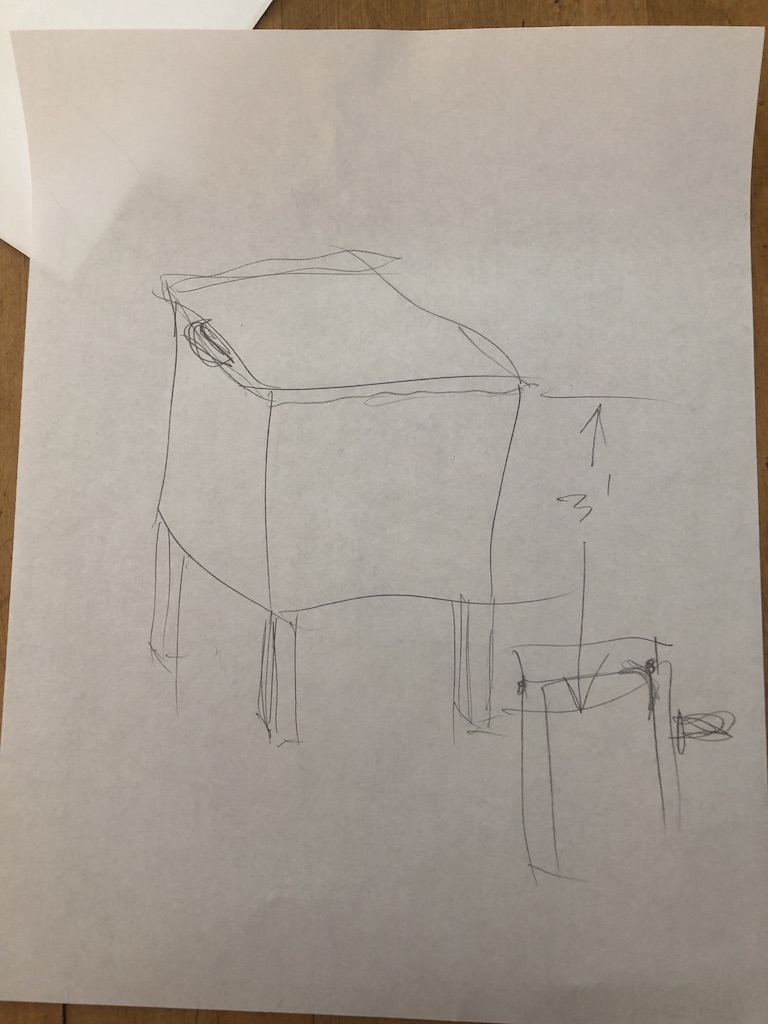
A high level design example of the ‘smart box’. It would be raised on stilts to make it easier for Emily to use
From these ideas and observations, we ultimately decided designing an anti-thief package device was the most promising and useful project to undertake among the ideas thrown around. The project not only satisfied the project criterion, but it also would present several challenges: the device must be easy for Emily to use and easily configurable, it must be ‘smart’ to not only lock once a package has been placed inside it but also not lock if an animal jumped into it, it had to be weather resistant, and most of all be thief-resistant. There are many different ways to tackle these problems, for instance we could raise the device on stilts so that Emily wouldn’t have to bend over to pick up a package, and we are excited to begin exploring practical yet thoughtful solutions.
]]>Meeting Agenda/Planning
We planned using a google document, the contents of which are displayed below, and decided we would mostly just let conversation flow as necessary.
DISCLAIMER: not in any particular order yet/doesn’t have to be
Introduction:
- Introduce ourselves: name, (what we made for project 2?), major, how long we’ve lived in/ like pittsburgh
- Ask Gary about why he volunteered for this project, about pittsburgh/work
- Explain project and goals/timeline
Main questions:
- Age, education/geographical experience?
- What did this morning look like for you? Does anything stand out to you? (anything memorable about your morning)
- Favorite part of the day? (what is something they enjoy doing)
- Why is it that you do what you do? (job wise)
- What motivates you to come to work?
- What was your favorite thing to do as a kid//something along those lines
- Something that is important to you? Why?
- What do you worry about?
- What is something you have wished for multiple times to change?
- [maybe later] what do you hope to gain from this project– basically directly asking if there is anything he thinks could be fixed
Make a mock-up of possible idea(s)? ALSO DON’T FORGET TO TAKE PICTURES
- Make sure he has our contact info, remind him he can email us with questions or ideas if he wants at any time
- Tanvi mostly talking, Karan mostly notes, Eric documentation/talking
Meeting Summary/Takeaways
Our discussion with Gary began with him talking about his work and education. Gary has an education in neurophysiology, and his current practice began about 35 years ago. His business grew from its beginnings in Pittsburgh to being a multi-state business. He spoke at length about his work in the operating room, taking electrophysiologic and neurologic measurements, and how he enjoyed the intellectual stimulation it gives him as well as opportunities to interact with younger people who join the business. Gary is retired, but uses his time to come into work whenever he wants and also pursue his own hobbies, such as drawing, breadbaking, videography, and photography.
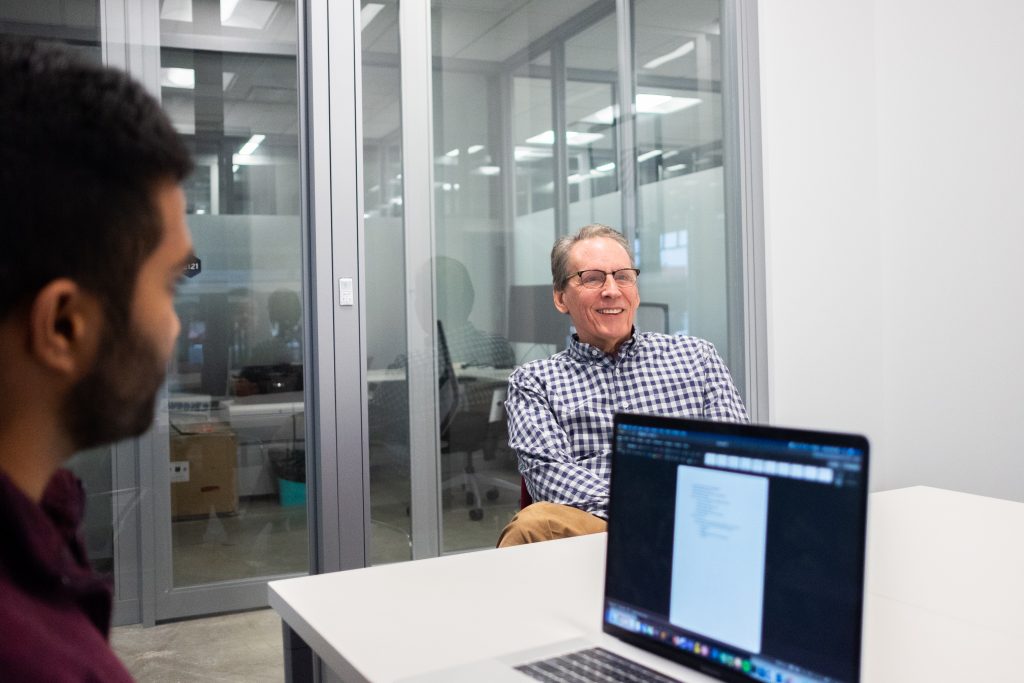
The four of us in a meeting room in Gary’s office building, Spaces. We asked him about something he least liked to do; he replied that he doesn’t really dislike any part of his life!
From there, we began talking about his experience traveling to different cities across the United States, as well as his personal vacations to other countries. Gary travels for about a week a month for work, but also enjoys traveling in his own time. For instance, we learned he would soon be visiting Japan as well as South Africa. We gathered that Gary is well-traveled, enjoys exploring, and usually has no issues during traveling time itself. We learned that Gary is interested in photography, and works on his skills as a photographer through taking pictures on his vacations. He mentioned that “the only thing is that the better cameras get heavy” and it becomes more difficult to wield them on vacations, but that high-quality cameras are unavoidably heavier because of the lens.
After we discussed Gary’s work and travel life, he suggested a few ideas of his own for devices that could help him. One was a timer for breadbaking – when he bakes multiple breads at once, he lacks a good way to keep track of all the different rise times. Another was a device that would help him hear the what the surgeon is saying in the operating room, perhaps using a bluetooth microphone, since he has a slight hearing deficiency. However, his favorite idea is a device that would help him quantify how strong one side of his body is compared to the other side. He told us he had a stroke a year or so ago, and has no way to definitively compare the strength of one side to the other. This frustrates him as it prevents him, psychologically, from engaging in harder physical activities he has previously enjoyed (such as skiing, hiking, etc.). The physical therapist he sees compares strength by hand and “just says ‘Oh, you’re fine'”, but Gary wants to quantify this, in a sense. He said knowing how strong his weaker side is compared to his other side, as well as compared to others in his age group, would make him more comfortable returning to his active lifestyle. We spent quite a bit of time discussing this and possible forms the device could take.
Thoughts
The conversation flowed much more smoothly than we anticipated; we didn’t consult our planning document once and Gary was more than willing to talk to us about his work and personal life. He has a lot to say and is very passionate about what he does, so we were able to sit back and just listen to him talk at times. However, this did mean that we didn’t quite follow our agenda and didn’t ask all the questions we intended to. I personally wish I had asked just one more question: “What worries you?” I think (if Gary didn’t reply with “Nothing”) this would have given me a better understanding of what Gary really cares about.
Our initial impression of Gary was that he was very mentally sharp and engaged with the world around him. He seemed very comfortable with his life and mentioned that there was little about his life he didn’t enjoy, which made it somewhat difficult to find areas we could ask him to elaborate on. He seemed to realize this, though, and gave us some of his own ideas to consider. However, I feel that he did most (if not all) of the ideation during our meeting, and I wonder if our own idea for an assistive device for Gary would have been different if he hadn’t given us those ideas.
Overall, speaking with Gary was a pleasure and we all felt that the way moving forward from the meeting was clear. Gary had a conversation with Zach prior to our meeting, so he knew the ins and outs of the assignment before we stepped into his office. He knew what he wanted us to make before our conversation happened, which made our task of finding a “need” for an assistive device in his life rather easy. Because of this, our assistive device will be exactly in line with what Gary wants. However if we were to do this a second time, we would make sure to ask the important questions we had planned out, just so we could form our own impression of the situation and make the ideation more two-sided. Additionally, we were unable to meet Gary at his house as he lives in Sewickley, so we couldn’t ask him to demonstrate the exercises he had to do in his personal gym and see how he interacts with the space in his own home. Most of the information we were able to obtain from this interview was through his words and body language, and I feel that we might have learned more if we had interviewed Gary in his home.
]]>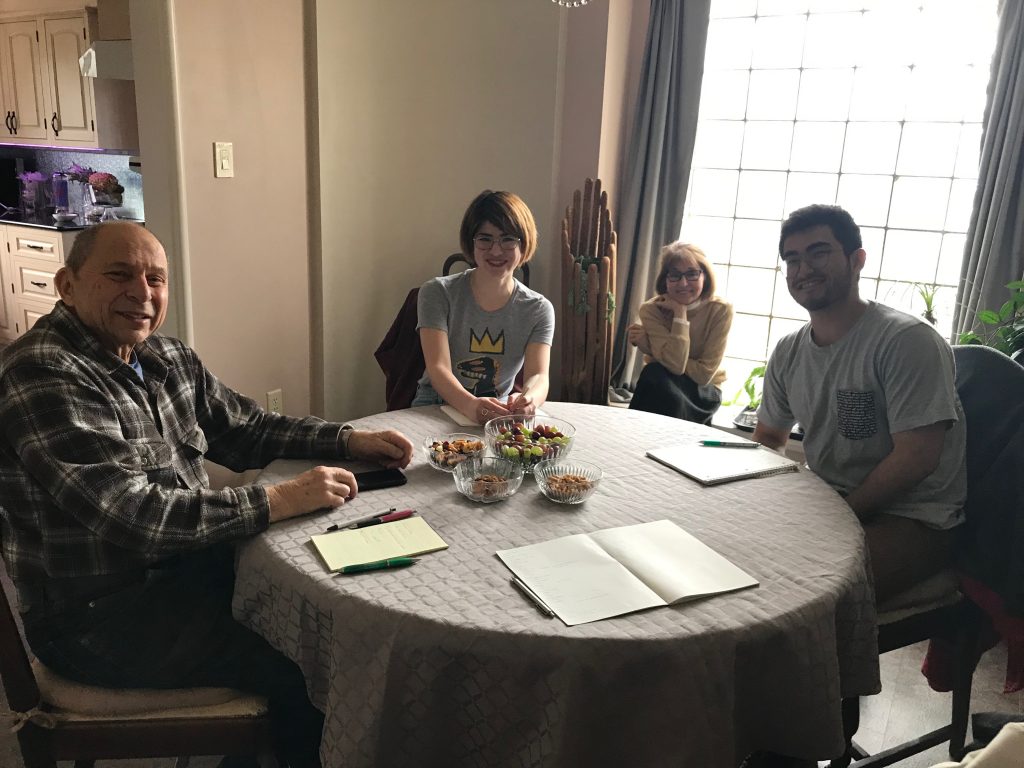
Irv and his wife Lois welcome us into their house with snacks and a friendly cat, Buttons
This meeting’s purpose was to meet with our Osher student Irving “Irv” Lieberman and get to know his daily routine so we would be able to narrow down what we should design for his convenience machine. We planned to meet with him Sunday morning, March 24th, in his home to discuss his lifestyle. We wanted to go to his house so we would also be able to see how he lived. Our goals for the meeting were to get as much information about Irv’s hobbies, daily routines, responsibilities, and aspects of life that we could make more convenient. We want to make sure we keep Irv in the loop when it comes to creating this convenience device because it is for him after all.
Meeting Agenda
Before meeting with Irv, we planned out how we wanted to conduct the interview and what we hoped to learn from this experience.

Meeting Overview
Irv’s Background
Irv and his wife, Lois, live in a house at the top of the Squirrel Hill neighborhood. Their house has rough stone steps, steep staircases, and plenty of room for gardening. Irv, originally from Bronx, NY, has a PhD in electrical engineering. Throughout his career, Irv worked with lasers and atomic clocks, and was involved with many patents. His career brought him to Westinghouse in Pittsburgh where he mainly worked with energy. Irv and Lois have no children and two cats. Since Irv and Lois do not have children (and as a result, no grandchildren), they do not have members of the younger generation to teach them how to use new technology. So, while they both have iPhones, they struggle with this new interface that is less analog. Overall, Irv is a very capable and handy person, always fixing things around the house and comfortable working on technical projects.
A Day in Irv’s Life
Irv stays active by maintaining his garden around the house, by taking care of weeding, laying manure, and by trying to keep the deer away from his plants. His house is very old, so it needs constant work. He told us that he’s had to repair sinks, and redo the electrical in some of the rooms. His kitchen is very decked out with shelves on wheels that you can hide under the kitchen counter, adjustable LED lighting over all his counters, and electrical outlets all around the island in the center of the kitchen.
The video below shows innovative kitchen shelf unit that Irv designed and constructed.
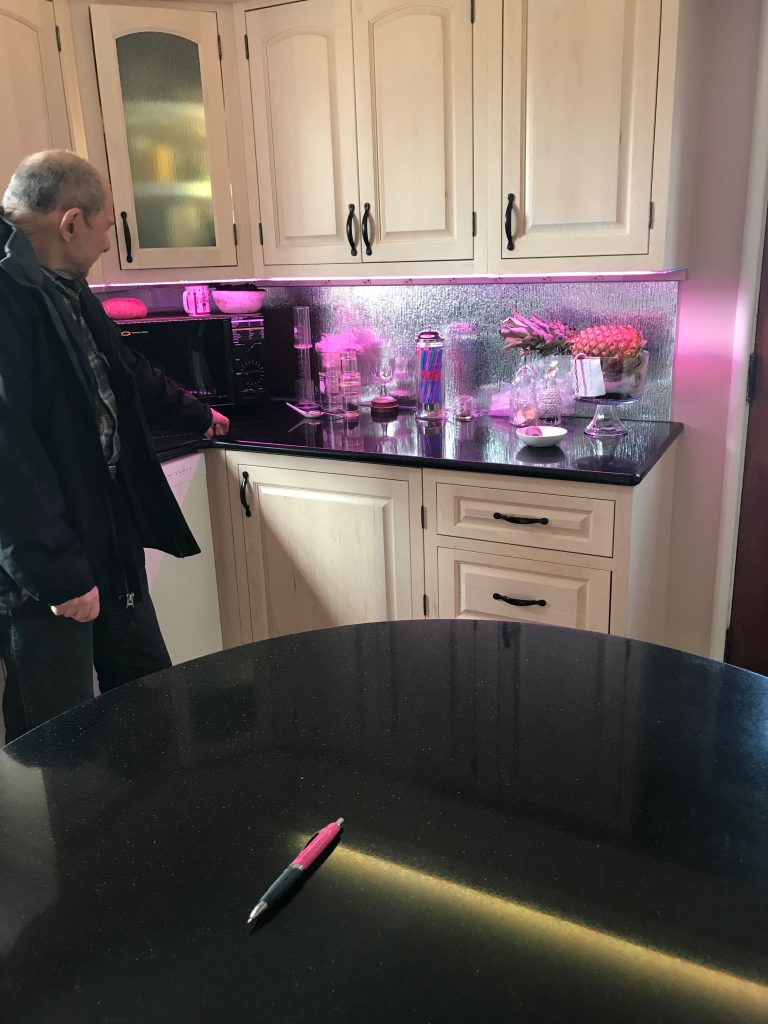
Irv installed adjustable LEDs inside the frosted cabinets and around the perimeter of his kitchen counter
He also plays tennis and works out. He keeps his mind active by going to Osher classes, and since he has a Ph.D. in electrical engineering, he is able to take some of the more technically challenging classes like astronomy. Him and his wife Lois also enjoy going to cultural events like the opera, symphony, ballet, and dinner parties with friends. Even though they have a car, they enjoy walking and taking the bus if they have time.
Some Obstacles
In spite of maintaining a very active and social lifestyle, Irv admitted to facing certain obstacles as a result of aging. To start, he told us that understanding new software (like iphones) was often difficult for him, especially since he had no children or younger people around to help explain the technology.
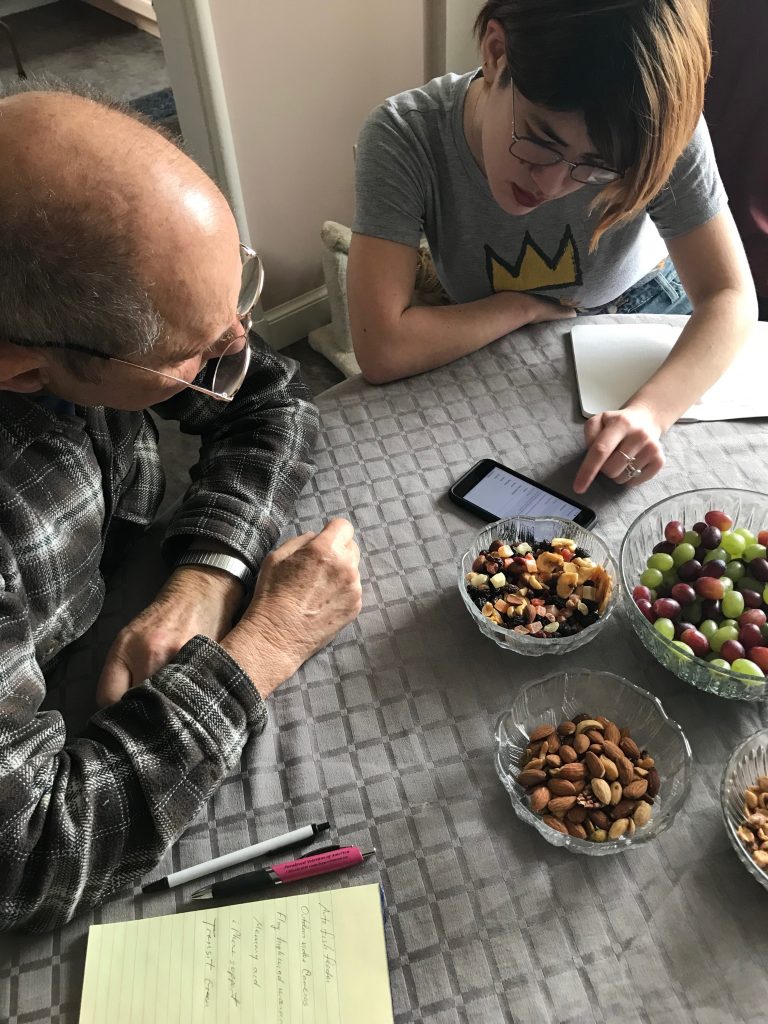
Eliza shows Irv how to add a vibration to his phone so that he knows when he gets a notification
Additionally, his desire to complete his own housework, like weeding and washing his car, is hindered by physical exertion and a bad knee. Irv also mentioned having some problems with hearing. Over the course of the meeting, we noticed that Irv didn’t hear the clock chime or the new texts on his phone since they were prompted solely with audio notifications. While this doesn’t drastically impair his daily activities, we noted that we should use non-audio sensory alerts (like vibrations and visual cues) when brainstorming potential devices. Nearing the end of the interview, we learned that Irv has trouble staying on time and keeping his reminders organized.
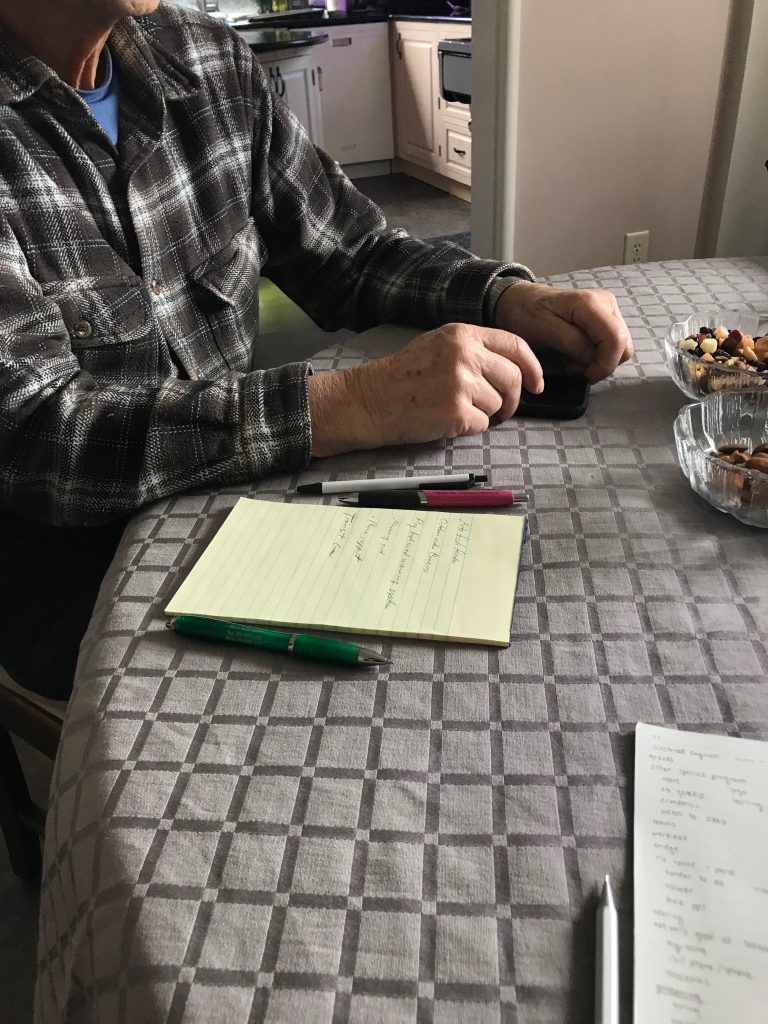
Irv takes notes and makes a list of reminders for himself during the meeting
He seemed to take interest in this issue as a point for intervention, so we started to develop ideas for a type of portable reminder device that could keep him on schedule via vibrations or flashing lights.
Discussion
Our first meeting with Irv was very successful and productive. We wanted the meeting to be less like a interview and more like a conversation between a group of people, which we succeeded in doing. In other words, we did not try to structure our meeting in parts. Instead, we bounced between conversations about Irv’s background, our own backgrounds, and Irv’s current lifestyle. We concluded that based on his active lifestyle, work around the house, and customized kitchen, Irv is a very capable person and doesn’t require much assistance. After having a productive meeting with Irv, we decided to lean on the convenience side of this project, as opposed to the assistive aspect.
While Irv was very willing to talk about his work as an electrical engineer and his life in Pittsburgh with his wife, Lois, he was reluctant to give details about things he struggles with. For instance, when we were discussing the difficulties of gardening and maintaining the house, even with some prodding, Irv did not specify what specifically was hard and only said that gardening is a tiring task. However, having Lois sit in on the meeting was very beneficial because she would interject when Irv was vague about what he struggles with. She brought Irv’s bad knee, back, and hearing to our attention. Overall, having Lois for a second input helped us narrow down the ways in which we could work with Irv.
Some things we could do differently next time is get more insight to his daily routine by getting a tour of their house or seeing them demonstrate different parts of their daily lives. We got a glimpse into Irv’s capabilities when he and Lois showed us the all the gadgets and renovations in the kitchen. He is a very independent, smart, and active person. Overall, the meeting was very successful and we feel like we built a solid foundation with Irv. We got to learn a lot of Irv, as a person and as a client, and discover many interesting aspects of his life here with Lois.
]]>On March 25th, Monday morning, Alton, Seema, and I (Vicky) went to Peter’s home to introduce ourselves and got to know more about him and his daily life. We also briefed him on our final project, which is creating an assistive device that will help aid an older person’s needs and/or desires. We chatted about how he typically goes about his week, briefly walked around his place, and met his wife and two cats.
Meeting Agenda
Before meeting Peter, we constructed a loose agenda and a couple of starter questions, in anticipation of facilitating conversation.
Course of Action:
- Introduce ourselves!
- Ice breaker by just talking about commonplace topics like our day
- Ask about his typical schedule and hobbies
- Brief him on the project
- Understand more about any daily problems, issues, and/or needs that he wants to be solved.
- Start discussing ideas for the final project, and brainstorming together possible solutions and/or key features to be included.
Possible Questions
- What are some hobbies / interests that you have?
- What are some day-to-day activities that you go about that have become more difficult over time?
- Can you demonstrate (daily activity)? A morning routine? A nightly routine?
- Can you describe your favorite / most meaningful / most practical item? Why is this item important / helpful to you?
- Can you describe / sketch out an item that is annoying to use, but one you use daily? Why is this item annoying, and what aspects of it do you wish you could change? (Demonstrate the changes through drawing)
- Can you express your level of frustration on a scale of smileys when dealing with said frustration(s)?
Summary
We visited Peter at his penthouse apartment home. Before we began the formal interview, he showed us around and took us out to his balcony. It’s a nice porch area with a great view of the city, but Peter casually noted that they experience some really gusty winds up there and have to actually chain down all the furniture on the balcony.
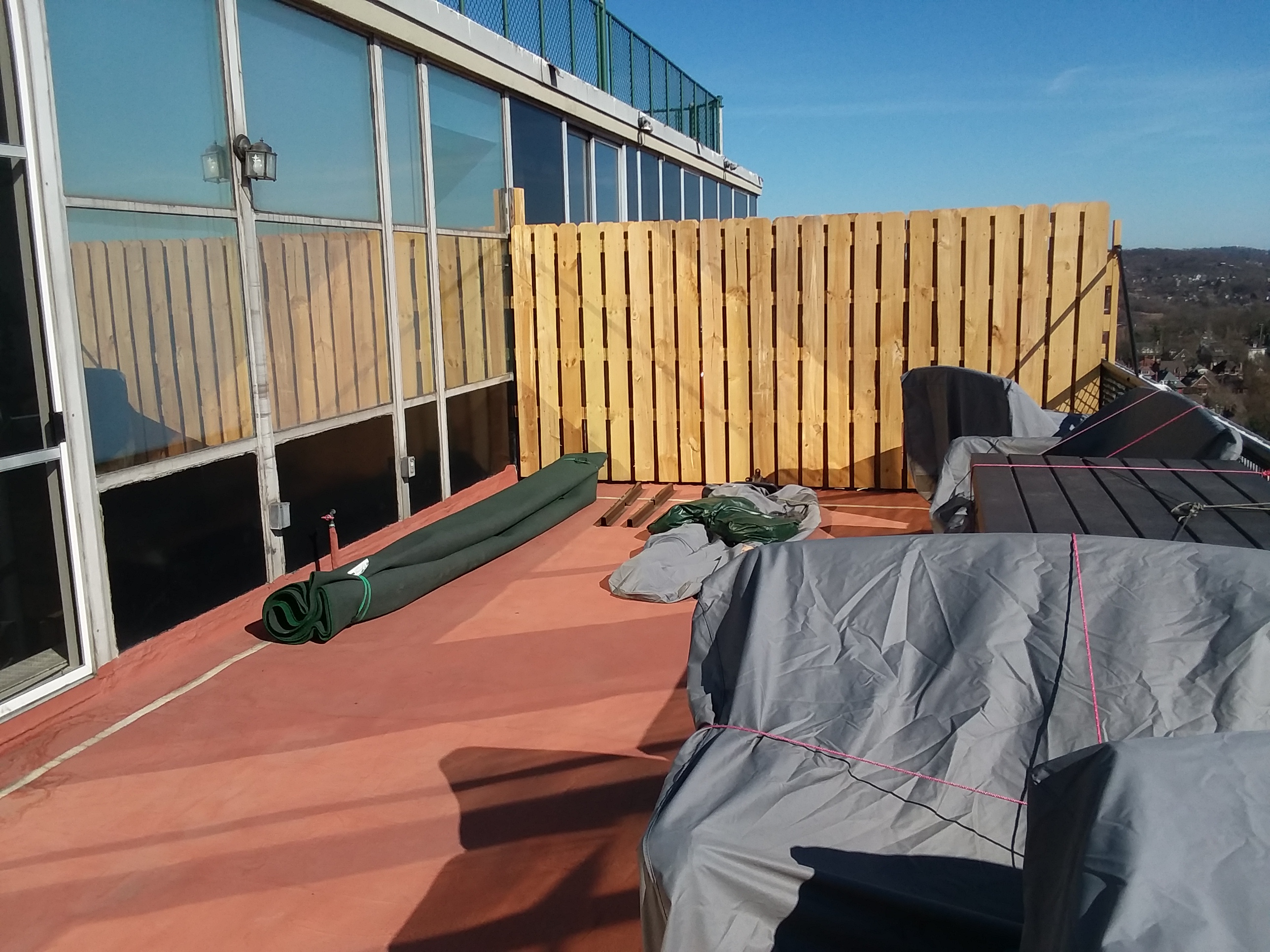
His balcony with some furniture tied down
After walking around his living room area, we introduced ourselves, starting with basic background information and casual hobbies:
Background info
- Retired 2 years ago
- Has two 19 year old cats
- PHD in ECE from CMU
- Lives in a penthouse with balcony
Additional Hobbies
- Stargazing
- Camping with his telescope, enjoys setting it up for family events and the public
- Volunteers at the zoo with his wife
Then we walked through Peter’s typical week. Although retired, he keeps himself quite busy:
Typical week for Peter
- Osher classes (takes the bus or drives to CMU)
- JCC 4x/week to work out
- Helps son-in-law with his business by getting quotes and talking to potential clients
- Plays bridge 2x/week
- Lots of cycling to raise money for Multiple Sclerosis- they bike from pittsburgh to lake Erie so they need to train a ton
- Babysits granddaughter (who isn’t allowed on the balcony because that may be dangerous)
Major Takeaways
We talked about a lot of his daily activities to try to probe for something that could use an assistive device, but couldn’t find any leads. Peter seemed content with his current lifestyle, and had no blatantly obvious problem that could not be solved with a current on the market, technological solution. The only other problem he had was the AC didn’t reach the area near his couches, but that’s not something we can realistically fix without working in his house all the time.
Therefore, we came to the conclusion that we would create a more personalized solution for a problem that was on his mind for a while — the wind detection sensor. Instead of just purchasing a commercially viable wind sensor that would tell generic wind speed information, we brainstormed and explored possible ways that would be subtle, interesting, and tasteful, when determining the wind speed outside. With this possible solution, Peter would be able to determine whether or not the weather outside is optimal for him to go out on certain days, whether or not to tie down his furniture on other days, and/or be able to just have general knowledge of what the wind speeds are like.
Reflection
Later, we discussed and realized how he must have had a desire to have a wind-detecting sensor for a long time — as he had from the very beginning hinted at the strong wind speeds when taking us around his house and discussing more about his daily activities — but has not yet found one that accommodates all his needs for a sensible price point. We thought it would be something that would help with a hobby or daily task, and also weren’t expecting our solution being able to survive extreme weather as an extra challenge.
With Peter, we brainstormed that it would be more optimal to have one part inside and the other outside, so that we only need the sensor part to survive the weather conditions. We also realized that we would need to buy a sensor that can sense over 100 mph wind speeds.
Then, we began to explore how we could possibly have the sensor part communicate with a notification part that’s inside. Current ideas include:
- Raspberry pi
- Wifi module
- Bluetooth module
For getting the weather information on wind speed, we want to try and do something similar to what Zach did with the tide information. However, the trouble with predicting the weather for his balcony height from the predicted wind speeds from the height that weather stations take the measurements at.
Our meeting with him followed our agenda quite well, but the problem we needed to assist him with wasn’t what we expected. We thought it would be something that would help with a hobby or daily task as well as weren’t expecting it to need to survive extreme weather as an extra challenge. As a whole conversation went pretty smoothly and we were able to seamlessly go from one topic to another. Our biggest issue was just finding anything that he needed assistance with.
]]>
For this meeting, we were focused on getting to know Richard, and finding out some areas where he felt his life could be improved by our making of some sort of device to help him in that area. We met at Richard’s apartment on Tuesday, March 26th at 4:45 PM. All three members of our team, Adrien, Nathan, and I(Erin), were present.
Agenda
- ICEBREAKER – tell him our names and majors, and why we took Physical Computing. Ask why he chose to participate in the OSHER class he’s taking and this particular project
- Explain project goals/answer questions he might have, explain timeline of project
- Give examples based on our assistive devices of what an assistive device can look like.
- Adapt below questions based on where our conversation leads us:
- Ask him to walk us through a typical day (or, specifically, what he did today), and show us around his apartment if possible.
- Are there any activities in your daily life that are difficult or frustrating? Maybe have him walk us through what stresses or frustrations he’s had today
- What’s something you used to enjoy doing which has become harder with age?
- Once we narrow down to one or two pain points:
- Could you walk us through that activity?
- Draw a map of the steps through that activity?
- Draw/model a “magic” device that could make it easier?
- Wrap Up – Take any needed extra pictures/documentation, say thanks
Summary + Major Takeaways
When we spoke to him, Richard already had some ideas for areas in which a new device could be beneficial. The two areas of interest were something that would help position his iPad when he was using it to draw on the couch and could track the time he’d spent working on it so to make better estimates for his jewellery commissions, and something that would help him with his hydroponics system. We decided to focus in on the device for his iPad, as that was the area where he felt like there wasn’t already an exact solution for it.

Richard demonstrating how he uses his iPad to draw sketches for jewellery commissions on his couch.
At night, Richard sits on the couch with his iPad on a pillow on his laps and draws for jewellery commissions while he and his wife listen to the news. During this process, he has to move and tilt his iPad around to draw, which he finds a bit cumbersome. He was interested in some sort of lap desk-type-thing that would help do some of this work for him.
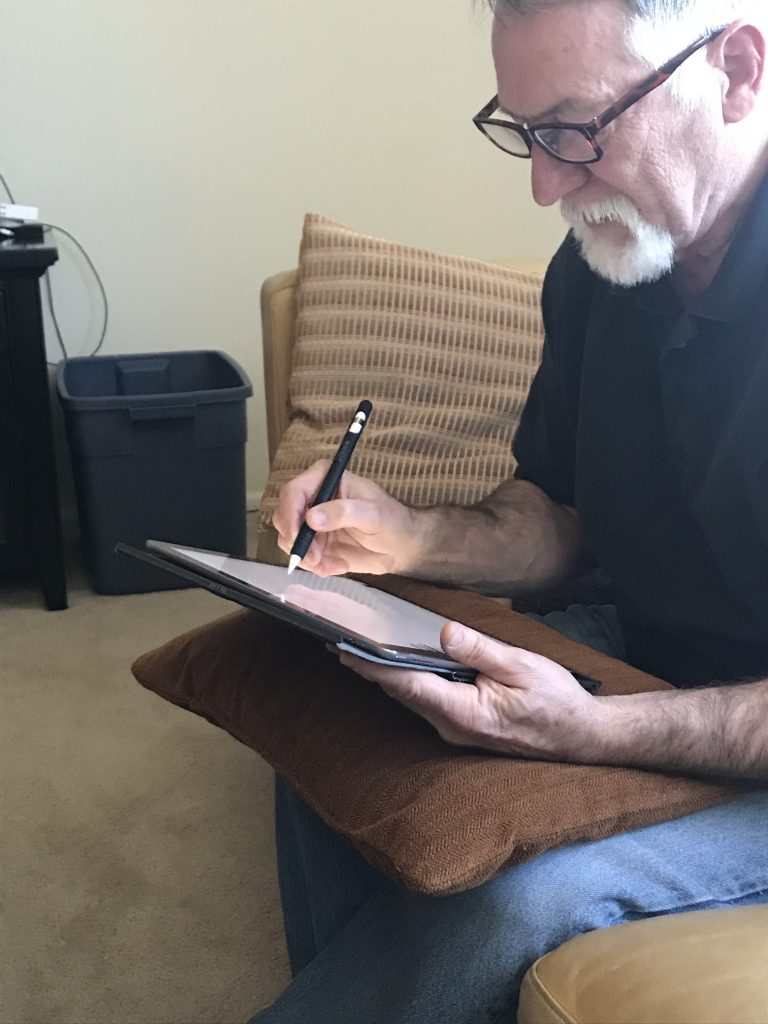
Close up – notice how he has to use his hand to support his iPad.
Some features he was interested in having for this holder included
- Something to help with positioning his iPad – preferably digital, since he said that he could already move it with his hands
- A slot for his pen
- Something that would keep track of how long he’d been drawing for reference when making invoices for his jewellery commissions
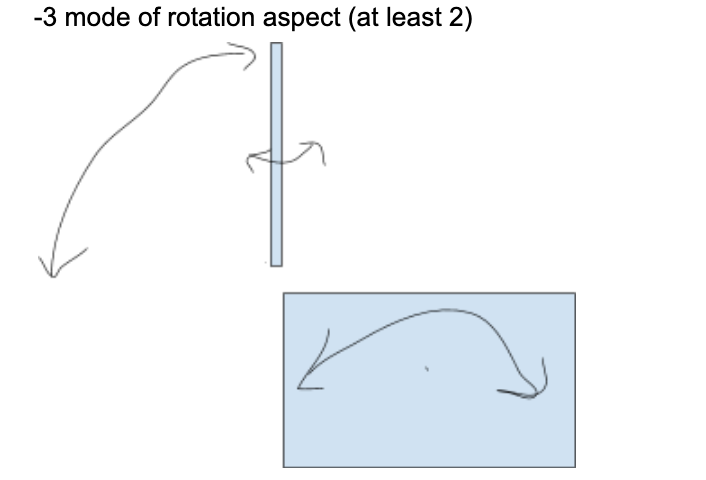
Sketch Nathan made during the meeting of the freedom of movement Richard wanted from his iPad when attached to this device.
Thoughts
Because Richard had thought about the prompt beforehand, our meeting with him deviated from our original agenda in that it was a lot more direct – we didn’t have to spend a lot of time identifying the problem area. While Richard gave us a fairly clear cut idea for what he wanted, we thought this project could pose some interesting design and technical challenges, in terms of the creation of the actual objects and setting parameters for the motion. I think next time I would have liked to have him draw what he was generally looking for, and have us as a group add on to it to think of more possible features. Overall, we all thought the meeting went well and was very productive.
]]>